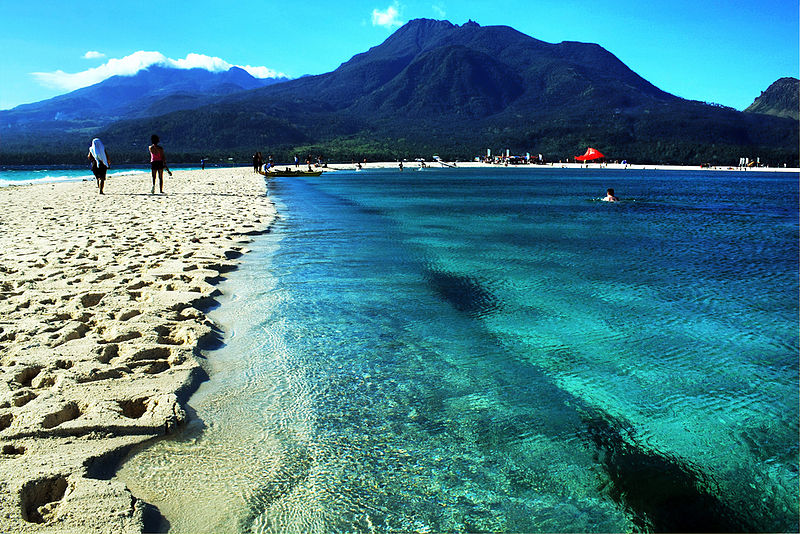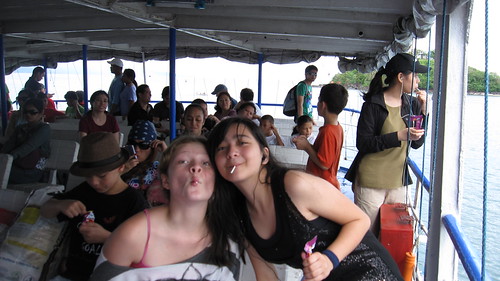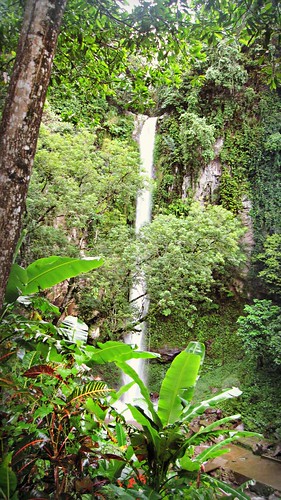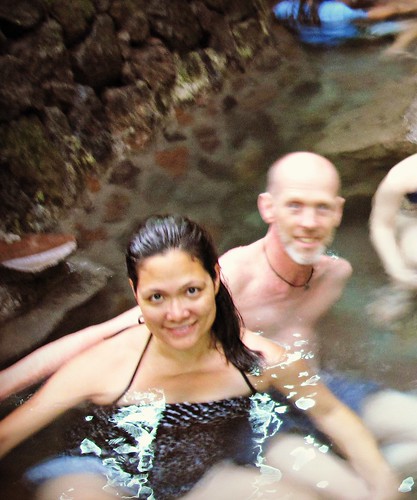Camiguin Island (as viewed from neighboring White Island), Philippines. Image source: Wikipedia Commons
To get to a remote island, you're going to need to do a bit of traveling, and getting to Camiguin is no stroll around the block. First you have to fly from Manila to Cagayan de Oro City (a 1.5-hour flight), on the island of Mindanao. Then you have to endure a drive of about 90 km to Balingoan port. That doesn't sound like much -- according to Google Maps it should take just over an hour to get there -- but the winding, 1-lane roads and excruciatingly slow vehicles we encountered meant that it took us over 3 hours, even with the van driver driving like a lunatic.
Once you get to Balingoan port, that's when the adventure really begins. A ferryboat leaves Balingoan port for Camiguin island every hour......ish. Sometimes ferries leave an hour apart, sometimes it's 90 minutes, other times it's two hours. It's almost impossible to figure out what time the ferry actually leaves because the crossing time varies with the tide and waves, and the darn thing seems to wait until it fills up with passengers before leaving. We ended up waiting 45 minutes instead of 15, which of course meant that everyone's potty break schedules were all off, and we couldn't hold it until arriving at our resort, as we had originally planned. Do you know why so many Filipinos pee in the bushes and trees? Because they're cleaner than the public restrooms. Fortunately we found a hole-in-the-wall eatery that let us use their restrooms for 5 pesos (12 US cents) per person. It wasn't the Ritz (we had to flush the toilets by pouring water into the cistern), but hey, this is the province.
The Balingoan-Camiguin ferry is nothing like the boats that glide along Paris' Seine river, or the boats that take tourists to and from Ellis Island in New York. This ferry is creaky, rusty, muddy and slow. Cars, trucks, livestock and cargo take up most of the room, and there is a small upper deck for human passengers. I'm a terrible sailor, so I was dreading the two-hour voyage, but the crossing was surprisingly smooth. The waters were pretty calm, and I kept my eyes on Camiguin Island the whole way.
Camiguin's economy is agricultural (fishing and farming), although the tourism industry is growing as more people from other parts of the Philippines and abroad are discovering it. There are no fast food restaurants in Camiguin. There are no shopping malls, unless you count the local markets (where my aunts actually bought little fruit trees to take home!), or roadside stands that sell hand-forged machete knives (called bolos).
Yes, I know the sign says it's a laundrette, but my mom had eyes only for the lethal weapons being displayed by the side of the road. She bought one to take home with her. No, she's not planning on going on some senior rampage, Filipinos use bolos to clear brush and weeds in their gardens!
I told her there was no way airport security would let through carrying a 12-inch machete blade, even in her check-in luggage, but she breezily assured me they wouldn't even blink -- and they didn't. I guess they're used to people traveling from Camiguin with bolos, fruit trees and all kinds of stuff.
Most of the houses around Camiguin are small and simple, but here and there you can find some prime examples of colonial Spanish architecture. My mother's uncle married a woman from Camiguin, and her family happens to own one of the oldest and grandest of those ancestral homes, so a group of us paid a visit and took a peek inside. From the stone walls of the first floor (that once housed the horses and carriages) to the huge windows in the second-floor family living area overlooking the street below, it's a classic Filipino Bahay na Bato. It looked so much like the home that my mother was born in, that I was swept by a wave of nostalgia for the days when I spent summers there as a little girl.
Our home away from home in Camiguin was the Bahay Bakasyunan resort, at the northern end of the island. Bahay Bakasyunan (pronounced BAH-hayee bah-kas-YOO-nan) means "vacation home", and guests actually stay in little cottages made from native building materials, so they resemble native homes. It's such a beautiful place, and I have so many photos and so many nice things to say about this place that it deserves a future post of its own. Stay tuned!
The main attractions of Camiguin Island, of course, are natural, not man-made. One of the must-see places is Katibawasan Falls. It's located in a clearing surrounded by ferns, trees and flowers. Water drops 250 feet from the side of Mt. Timpoong, into a small pool. Yes, it's like a scene straight out of South Pacific / Jurassic Park / Castaway / Blue Lagoon / insert your favorite island movie.
Unfortunately, it had rained hard the day before, so the falls were swollen and the current was fierce, and we were not allowed to take a dip in the pool. The kids contented themselves with clambering on the rocks and surrounding themselves with the spray from the falls, while the adults contented themselves with snapping a million photos.
We took a dip in the mineral pools of Ardent Hot Springs. They're located at the foot of Mount Hibok-Hibok, one of seven volcanoes on Camiguin and the most recently active. Ardent Hot Springs has several pools of varying temperatures, all fed by running streams heated by the volcano.
Last but not least, we visited White Island, a tiny sandbar just off the northern coast of Camiguin whose land area depends on how low or high the tide is (for more photos and descriptions, check out my White Island post).
There were several other attractions we didn't get to -- a few old churches, Soda Water swimming pool, the Sto.Niño cold spring, Mantigue Island, a sunken cemetary -- but we were there for only 3 days, so we had to prioritize. If we had stayed longer I would have liked to hike up Mt. Hibok-Hibok, go for a spin around the island with Alfie on a motorbike (the road circumnavigating the island is just 64km or 40 miles), and gone snorkeling (my scuba-mad cousin went on a dive off the coast and said the corals looked amazing). I would love to go back to Camiguin someday -- but the Philippines has over 7,000 islands, which means there are so many more to explore.....

Last but not least, we visited White Island, a tiny sandbar just off the northern coast of Camiguin whose land area depends on how low or high the tide is (for more photos and descriptions, check out my White Island post).
There were several other attractions we didn't get to -- a few old churches, Soda Water swimming pool, the Sto.Niño cold spring, Mantigue Island, a sunken cemetary -- but we were there for only 3 days, so we had to prioritize. If we had stayed longer I would have liked to hike up Mt. Hibok-Hibok, go for a spin around the island with Alfie on a motorbike (the road circumnavigating the island is just 64km or 40 miles), and gone snorkeling (my scuba-mad cousin went on a dive off the coast and said the corals looked amazing). I would love to go back to Camiguin someday -- but the Philippines has over 7,000 islands, which means there are so many more to explore.....


















1 comment:
Boracay is to crowded already, Camiguin might be a great alternative. From your picture the island looks beautiful as well..
Tourist Visa Australia
Post a Comment